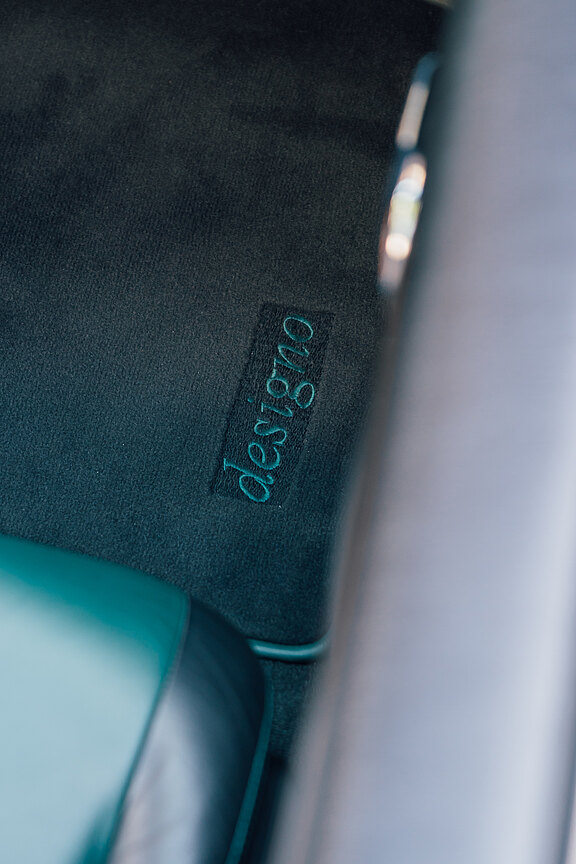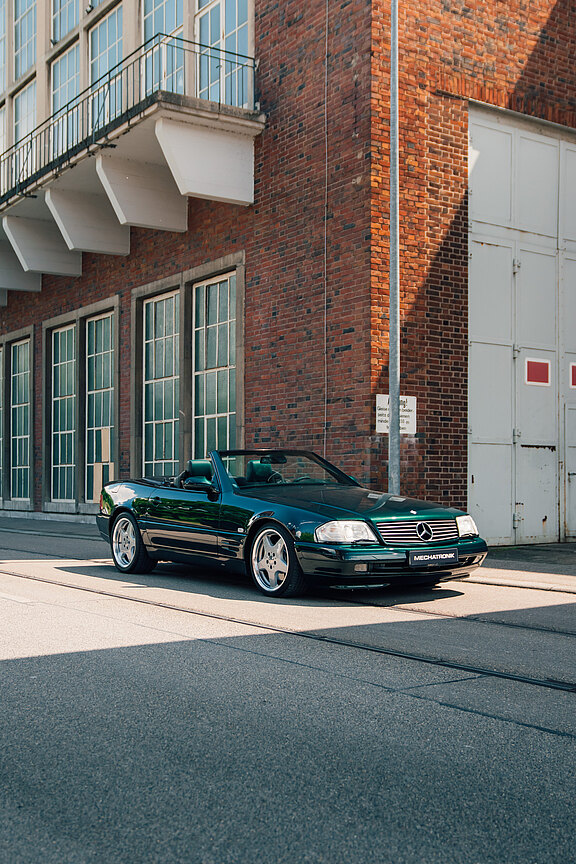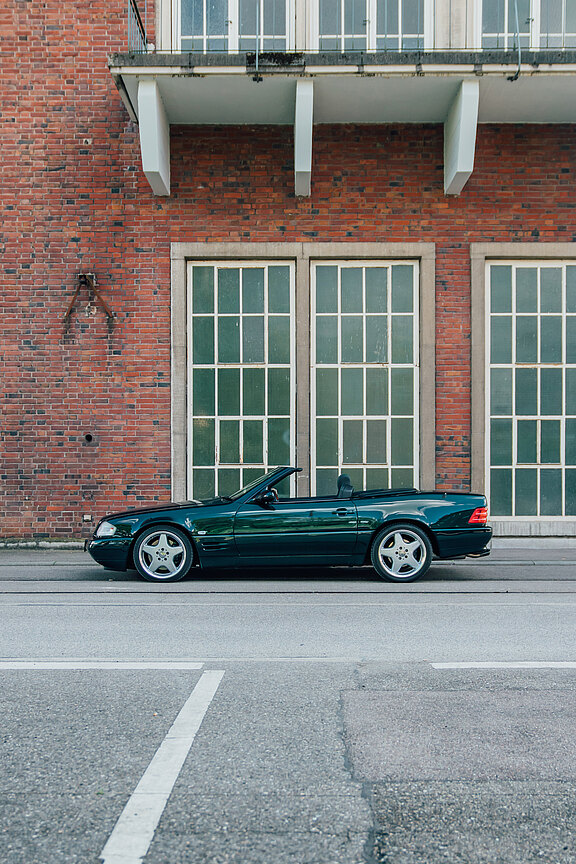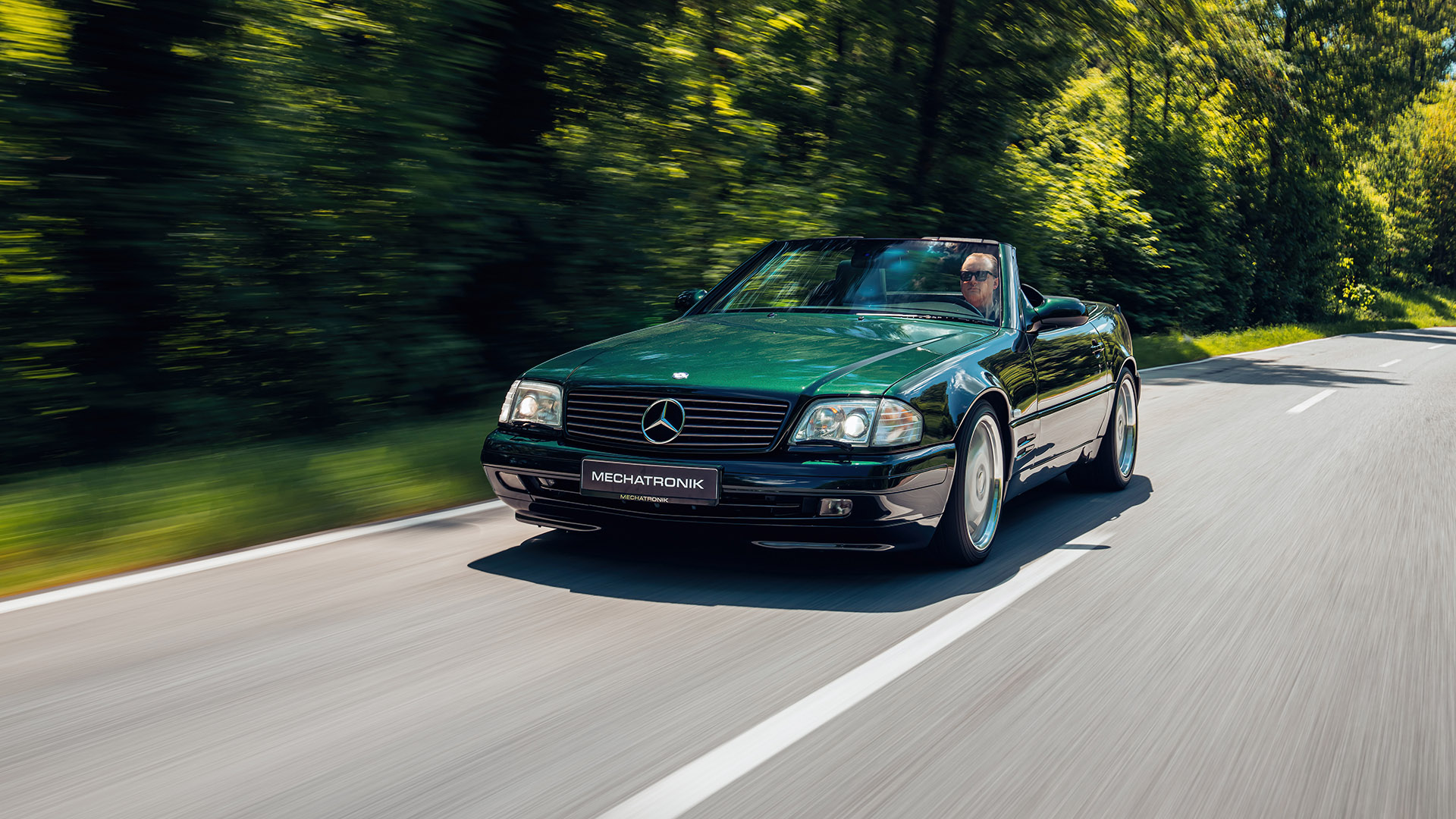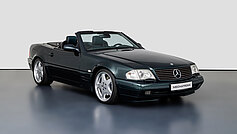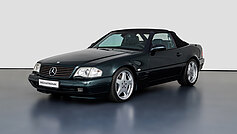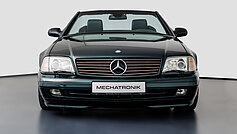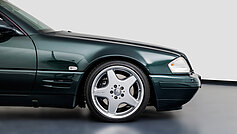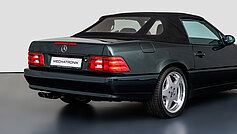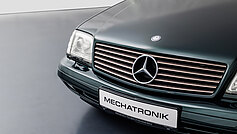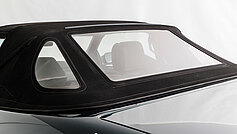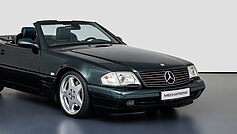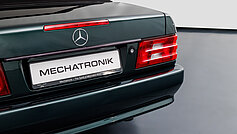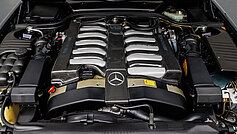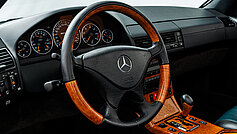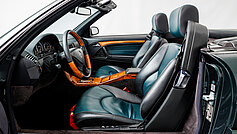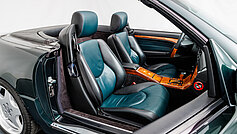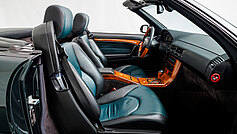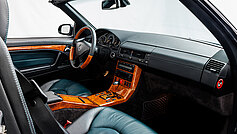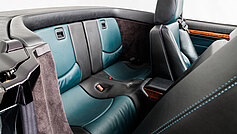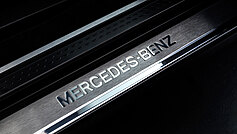Mercedes-Benz R129 SL73 AMG Roadster
- One of the rarest AMG´s ever built
- Less than 80 units produced
- Ordered ex works as SL73 AMG
- German delivery
- Identical engine to the legendary CLK GTR and Pagani Zonda
- Incl. complete on-board folder, data card, COC and operating instructions
- Only 17,200 kilometres and 3 owners from new
- Extremely rare special paint finish "Designo alanite green metallic"
- X59 Designo interior dark green two-coloured
- Incl. panoramic glass roof
- One of the most sought-after AMG`s on the market and a highlight for every Mercedes collector.
- Freshly completed customer service
| Year: | 1999 |
|---|---|
| Paintwork: | Designo alanitgreen metallic |
| Interior: | X59 Designo darkgreen two tone |
| Gearing Type: | Automatic |
| Mileage: | 17.200 KM |
|---|---|
| Power: | 525 HP |
| Fuel*: | Petrol |
| Price: | Sold |
* Consumption: 23.1 litres in accordance with DIN 70030, determined at 3/4 of the maximum speed, maximum 110 km/h, with a 10 % surcharge
GET IN TOUCH WITH YOUR CONTACT PERSON FOR THE Mercedes-Benz R129 SL73 AMG Roadster now.
Mercedes-Benz R129
The world premiere of the new R129 SL model series was one of the main attractions at the Geneva Motor Show in March 1989. The completely redesigned 300 SL, 300 SL-24 and 500 SL models had virtually nothing in common with the predecessor models of the R107 model series apart from the overall design. Significant improvements over the predecessor models were achieved in terms of passive safety. The lack of a roof structure necessitated a body structure that differed fundamentally from the closed variants and therefore required intensive development work. The desired dimensional stability of the passenger cell was achieved through the interaction of various structural elements. An integral part of the safety concept was the automatic roll bar, which was realised for the first time in automotive engineering and had the task of securing the passengers' survival space in the event of a rollover. In the event of an imminent rollover, the roll bar was triggered electromagnetically by sensors within 0.3 seconds. The bar could also be deployed at the driver's request. The hardtop was now made of light metal and was therefore 10 kg lighter than the hardtop of the previous model despite the larger window areas. Overall, a reduction in the bodyshell weight was achieved through lightweight construction, which at 405 kg was only 20 kg higher than that of the predecessor model despite improved structural safety. Another key aspect of the SL-specific occupant protection was the newly developed integral seats, which provided increased protection in the event of a side impact thanks to their load-bearing structure with high lateral rigidity. The load-bearing seat frame, which consisted of five high-strength die-cast magnesium parts, also made it possible to integrate the belt system with belt tensioner, the belt height adjustment with coupled headrest adjustment and the full-electric adjustment functions into the seat.
The electro-hydraulic soft top, with which the R129 was equipped as standard, offered a particularly high level of comfort. The soft top could be opened within 30 seconds and stored in the soft top compartment or removed from the compartment and closed. At the same time, the side windows and the roll bar were lowered and then returned to their original position. Another innovation that was available for the first time for the SL 129 model series was the so-called "wind deflector". The wind deflector consisted of a framed, air-permeable grille that could be attached to the roll bar in a few simple steps and, when raised, significantly increased driving comfort when the soft top was open by minimising wind noise and draughts. In keeping with their sporty aspirations, all models in the 129 series were fitted with 16-inch alloy wheels with a 15-hole design and 225/55 ZR 16 wide tyres as standard. The larger wheels compared to the predecessor models allowed the installation of generously dimensioned brakes, which were appropriate for the improved performance of the new SL. The front fixed-caliper disc brakes, which had four pistons with different diameters in pairs, were a novelty. This design, used for the first time in a Mercedes-Benz passenger car, ensured even wear of the brake pads and better utilisation of the pad volume. This design, used for the first time in a Mercedes-Benz passenger car, ensured even wear of the brake pads and better utilisation of the pad volume. The ABS anti-lock braking system was included as standard on all three models.
The engine range also combined the familiar with the new. All three engines in the original model programme were equipped with a regulated catalytic exhaust gas purification system as standard. The 3.0-litre six-cylinder engine of the 300 SL had proved its worth for years not only in the predecessor model, but also in the 124 and 126 series saloons, and was now used in the new SL in a revised version. The most important improvement measures consisted of a redesign of the combustion chamber, which reduced the raw emissions of unburnt hydrocarbons, and a modification of the exhaust gas purification system. By eliminating the thermally highly stressed pre-catalyser close to the engine, increasing the cross-section of the exhaust pipes and the now dual-flow catalytic converter, the rated output of the M103 was increased from 180 hp to 190 hp. The 3.0-litre four-valve engine of the 300 SL-24 was a new design, which was developed from the M103 and largely corresponded to its two-valve counterpart in terms of engine components. New features were the four-valve cylinder head and the map-controlled adjustment of the intake camshaft, which was used for the first time at Mercedes-Benz. In conjunction with a higher compression ratio and an electronic ignition system with anti-knock control, the four-valve M104 produced 40 hp more power than the M103. The 500 SL caused a particular stir at the Geneva Motor Show. As the top model of the new SL series, it was equipped with a 326 hp 5.0-litre V8 four-valve engine, making it the most powerful Mercedes-Benz production car. The design of the M119 V8 four-valve engine was based on the M117 5.0-litre light-alloy engine, which had been tried and tested for over ten years. Extensive modifications were made to the crankcase, crankshaft and connecting rods in order to achieve the higher performance values. The two four-valve cylinder heads were a new design which, like the six-cylinder, had adjustable intake camshafts. In addition to the switch to four-valve technology, the anti-knock control and the changes to the exhaust gas purification system were decisive for the increase in power and torque: like the two six-cylinder units, the four-valve V8 also had a two-flow catalytic converter with a larger cross-section, with the pre-catalyser being omitted. Production of the new SL models did not take place in Sindelfingen, as with its predecessors, but was relocated to Bremen for capacity reasons; main series production started there in March 1989.
From October 1992, three and a half years after its presentation in Geneva, the SL was also available with the approximately 400 hp 6.0-litre V12 engine, which had already proven itself in the saloons and coupés of the W140 series. To further reduce pollutant emissions, the injection system was modified and mixture enrichment at full load was dispensed with. The most powerful engine in the passenger car sales programme thus mobilised "only" 394 hp, 14 hp less than the original version. The new top model in the series was equipped with a whole range of extras as standard, which were only available for an extra charge on the 500 SL. In addition to the adaptive damping system with level control on the front and rear axles, the standard equipment included cruise control, automatic dimming interior mirror, headlight cleaning system, automatic air conditioning, leather upholstery and heated seats. Externally, the 600 SL could only be distinguished by the type plate and two "V12" emblems, which were attached in the area of the air vents behind the front wheel cut-outs. With the appearance of the new top model, the 500 SL was also slightly revised. The version of the V8 four-valve engine with Bosch KE-Jetronic that had been used since then was replaced by the "standardised top engine" that had already been used in the 500 E and in the S-Class saloons and coupés. Characteristic features of the new engine were the modified crankcase and the Bosch LH-Jetronic electronic injection system with air mass measurement. As with the V12 engine, full-load enrichment was also dispensed with in order to reduce pollutant emissions, a measure that affected not only the SL but also all other passenger car models with V12 and V8 engines. In the case of the 5.0-litre engine, this meant a loss of 6 hp.
At the end of April 1998, an updated SL model programme with newly developed engines and a slightly revised design was presented at the Turin Motor Show. One of the most important measures as part of this model update was the introduction of the new V-engine generation with six and eight cylinders, which now also replaced the in-line six-cylinder engines of the M104 series and the V8 unit of the M119 series in the SL. Thanks to three-valve technology and dual ignition, the new engines consumed up to ten per cent less fuel. The top-of-the-range SL 600 model continued to be powered by the twelve-cylinder M120 engine, while the SL 60 AMG was dropped as part of the facelift and was no longer available from June 1998. In spring 1999, two particularly powerful AMG models were added to the model range of the 129 series: the SL 55 AMG was equipped with a 260 kW (354 hp) V8 engine, while the V12 unit of the SL 73 AMG even mobilised 386 kW (525 hp) with a maximum torque of 750 Nm. Although the top speed of the two top models was also electronically limited to 250 km/h, the limit could also be cancelled at the customer's request.
SL73 AMG Chassis No. 5564
The SL73 AMG on offer here is one of the rarest AMG model series of all. Less than 80 examples were produced. Vehicles were often converted years later, which emphasises the significance and importance of the fact that in this case the original order for the car has been placed. The car was ordered by the first owner, a law firm in Munich, on 10 March 1999. This was submitted to the Mercedes-Benz branch, also in Munich. The 2nd quarter of 1999 was given as the non-binding date. The equipment of this SL73 is second to none, starting with the special colour "Designo Alanite Green metallic" which we have never seen on any other SL73 to date, through the Designo interior in dark green two-tone, to the coveted panoramic glass roof. The extra costs from AMG alone totalled over DM 85,000. Added to this were all the special options for a further DM 30,000. A list price of DM 195,200 thus became DM 346,521 including VAT. Without doubt one of the most expensive and elaborate SL73s ever to leave the factory in Affalterbach. In addition to the options mentioned above, the customer decided to approve the top speed. Originally, all SL73s were limited to 250 km/h. It was first registered by the buyer on 27.07.1999. After 2 years of use, the first customer service was carried out at the Mercedes-Benz branch in Munich on 2 July 2001, with a mileage of 5,466 kilometres. The SL73 remained in its original ownership in Germany until September 2011, when it was sold to a Swedish collector on 12 September 2011. The collector only used the car extremely rarely and only drove just under 7,000 kilometres in over 10 years. On 3 May 2021, another customer service was carried out at the Mercedes-Benz dealership in Järfälla, Sweden. This took place at a mileage of 12,301 kilometres. It is also worth mentioning here that the original service booklet including the data card and the original SL73 leather folder are still present. The SL73 was finally sold to a Swedish dealer on 5 December 2023 and delivered to our company just a few days later. With this SL73, we are delighted to have one of the most collectible vehicles from AMG on offer and will be happy to answer any questions you may have at any time. Please note that vehicle viewings are only possible by prior appointment.
